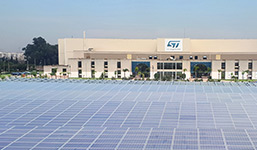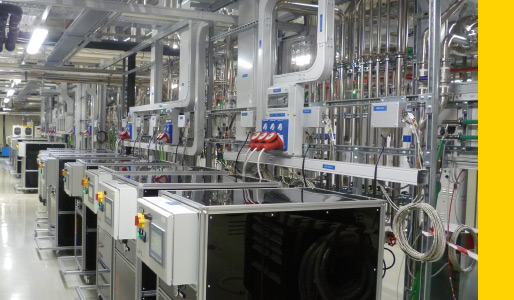Energy and Climate Change
Energy & Climate Change
OUR AMBITION
Continuously reduce our carbon footprint and our impact on climate change by decreasing our GHG emissions and improving energy efficiency.
2025 GOAL
-20%
energy consumption and GHG emissions*
* Normalized values vs 2016
Climate change is considered as one of the most serious global risks by the World Economic Forum. In ST, we recognize the importance of this global issue and take action to mitigate the impact of our activities. I 103-1 I
In 2019, we accelerated our efforts to address climate change challenges and introduced specific initiatives to significantly reduce our air emissions. As a result, we reduced by nearly 21% our greenhouse gas (GHG) emissions per unit of production compared to our 2016 baseline, achieving our target six years early. Thanks to this achievement, we are now working on more ambitious targets to move towards carbon neutrality.
We also confirmed our voluntary commitment to reducing our carbon footprint by joining the 99 signatory companies of the French Business Climate Pledge.
-21%
GHG emissions per unit of production compared to 2016
During the year, we reduced our energy consumption by 14% per unit of production compared to 2016 and we committed to more green sourcing (see Moving towards more renewable energy).
Our effective performance and management approach were recognized by external stakeholders as we received a B score in the CDP Climate Change, positioning ST above the global CDP average, above the Europe regional average and above the electrical and electronic equipment sector average, which were all scored as C.
Summary of net CO2 equivalent emissions I 305-1 I 305-2 I 305-3 I
Decreasing our carbon footprint
In 2019, our absolute direct emissions decreased by 14% compared to 2018, highlighting the impact of the numerous actions we have taken and the investments we have made in recent years.
Reducing PFC use and related emissions
Our direct air emissions (scope 1 of the GHG protocol) result mainly from Perfluorinated Compounds (PFCs) that are widely used in the semiconductor manufacturing process and for which there are not always alternatives. Reducing the use of PFCs and properly treating them before their release into the atmosphere is therefore a major element of our environmental strategy.
14%
decrease in absolute direct air emissions vs 2018
The 14% reduction in absolute direct air emissions is largely due to the installation of new abatement systems in our sites with the highest emissions rates.
In Ang Mo Kio (Singapore), we achieved a 21% reduction in CO2 equivalent emissions linked to PFCs compared to 2018, mainly thanks to changes in the gas process and the installation of new abatement equipment. Similarly, a new building at our Catania site (Italy) has been fully equipped with 17 thermal processing units, resulting in a reduction of over 7% in PFC-linked CO2 emissions.
We expect this positive trend to continue in future years thanks to our PFC roadmap, including the purchase of other new equipment and more gas replacement projects.
CO2 equivalent emissions I 305-4 I SDG 13.1
Per unit of production – normalized values
PFC emissions I 305-4 I
Per unit of production – normalized values
Compensating with trees
To help offset our remaining direct emissions, ST has developed CO2 sequestration programs based on reforestation. More than 6,200 hectares of forests were planted in Italy, Morocco and the United States between 2002 and 2005. These trees sequestrated 209,000 tons of CO2 in 2019, compensating for almost 38% of our annual direct emissions(1).
(1) Internal calculation method.

Dominic Tay Cho Seng
Central Maintenance Manager, Ang Mo Kio (Singapore)
With strong support from the Company, and in line with the Singapore Government’s determination to cut carbon emissions, we have managed to significantly reduce our PFC emissions. It is a very positive move given the forthcoming carbon tax and increasing concerns over global warming. It is our privilege and pride to be contributing to the battle against climate change and helping to secure a more sustainable future for humanity.”
Photovoltaic carport

FOCUS
Safeguarding the environment
Our Bouskoura site (Morocco) estimates it will reduce CO2 emissions by almost 740 tons per year thanks to a new 4,000m2 photovoltaic carport inaugurated at the end of 2019. The electricity produced by the 2,400 solar panels partially powers the clean room. The carport, among the biggest in Morocco, was installed and is run by GreenYellow, the Moroccan subsidiary of the French GreenYellow Group. This project is in addition to the 8,470m2 photovoltaic carport installed at our Catania site (Italy) in 2011.
“This is in line with our ambition to develop low-carbon electricity around the world and corresponds to a common desire to pursue our commitments and investments in green projects through the exploitation of renewable energies. In addition, it offers additional comfort to all our employees whose cars will be protected from the sun,” explained Fabrice Gomez, General Manager of Bouskoura.
Mitigating our indirect emissions with renewable energy
Our absolute indirect emissions (scope 2 of the GHG protocol) decreased by 11% in 2019 compared to 2018. This is a direct consequence of our increased use of renewable energy, as during the same period we consumed 2% more energy in our operations. It highlights the need to further increase the level of renewable sources in our energy mix and to improve the efficiency and management of our energy consumption.
Moving towards more renewable energy
26% of the total volume of energy we purchased in 2019 came from green electricity. Renewable energy makes up 70% of the electricity used by our sites in France, 30% of the electricity used by our sites in Italy and 13% of the electricity supplied to our Calamba site (the Philippines). In France, green sourcing helped us reduce our emissions by the equivalent of 41,192 tons of CO2, enough for 41,192 individual return flights from Paris to New York.
26%
of renewable energy
Our objective for 2020 is to significantly increase the sourcing of renewable energy in all our sites and more particularly in Italy and Morocco.
In 2019, ST joined a clean energy program initiated by a customer. In so doing, we confirmed our low carbon commitment and agreed to supply products 100% manufactured with renewable energy to this customer by 2021.
The construction of a photovoltaic carport at our Bouskoura site (Morocco) is another initiative implemented in 2019 to increase the use of renewable energy at our sites (see Focus).
Meanwhile, the solar power installations at our sites in Catania (Italy) and Grenoble (France) produced 2.1GWh of green energy during 2019.
Managing energy consumption
All our manufacturing sites continued developing initiatives to better manage their energy consumption and reduce ST’s footprint. These include investing in substation equipment at our Muar site (Malaysia) and energy savings programs at our Rousset site (France). During 2019, EHS teams at our front-end and back-end sites worked on 44 improvement projects, saving 18.45GWh of energy. I 302-4 I
10
sites certified ISO 50001
Exhausts and air recycling represent a big part of the electricity consumption at our manufacturing sites. Our Rousset site (France) introduced a project to improve exhaust capacity and optimize scrubber availability. Applying a Lean approach, people from various organizations (facilities, environment and operations) and with different skills, first identified the ‘mudas’ (waste) to eliminate. This highlighted several potential areas and opportunities for improvement, such as optimizing the settings on various items of equipment. This led to a sustained increase in performance, decreasing the acid exhaust flowrate by 13% and reducing electricity consumption by an estimated 900MWh.
Implementing a systematic approach to energy management helps improve our performance. At the end of 2019, our Muar site (Malaysia) underwent an ISO 50001 certification audit, joining the nine ST sites already certified (see ST site certifications).
2019 OBJECTIVES |
Status |
Comments |
|
-30% PFCs emissions (tons CO2 per production unit) by 2020 from 2010 baseline. |
|
-19% compared to 2010. |
|
|
+10% green energy each year. |
|
+25% compared to 2018. |
Adopting greener transport solutions
One commitment of our EHS Decalogue is to reduce CO2 emissions from the transportation of our employees and products (scope 3 of the GHG protocol). We report on three categories of scope 3: employee commuting, business travel and goods transportation. This represents 10% of our total CO2 emissions. In 2019, our scope 3 absolute emissions increased by 4% compared to 2018, mainly due to goods transportation.
Employee commuting and business travel
At ST, we encourage employees to play their part in combatting climate change by choosing greener mobility options such as bicycles, electric cars, buses and trains. In 2019, we reduced CO2 emissions related to employee commuting by 4%, thanks to various initiatives launched by our sites to promote eco-friendly alternatives.
- We installed electric car charging stations at our Shenzhen site (China) and corporate headquarters in Geneva (Switzerland). These two sites have now joined all our French sites, as well as Catania and Agrate (Italy), on the journey to green commuting.
- Our Zaventem site (Belgium) took the opportunity of European Mobility Week to encourage employees to commute by walking, cycling or using public transport, or to work from home. This led to a reduction of approximately 11% in CO2 emissions during that week, compared to a standard working week, as well as more employee awareness and engagement.
- Our Agrate site (Italy) has set up an ‘Isola Formativa’ (training island) that provides free bicycle management and maintenance for ST employees and their families, encouraging people to cycle more. This unique, sustainable and inclusive project taught five disabled trainees professional skills that will enable them to enter the world of work. The five-year project was developed in collaboration with Lo Sciame (The Swarm) a nonprofit social cooperative.
4%
decrease in CO2 emissions related to employee commuting
We also encourage our employees to use video conferencing and remote team meetings to minimize business travel.
Goods transportation
Emissions related to goods transportation represent about 50% of our scope 3 emissions. Whenever possible, we optimize loadings and routes. In 2019, our CO2 emissions from goods transportation increased by 12%, due to an increased volume of internal shipments.
Addressing climate-related risks
Through our Enterprise Risk Management (ERM) program, we identify and assess climate-related risks. The Business Continuity Plans (BCP) we implement at each site help prevent and protect our operations against climate change and natural disasters (see Risk Management). We adopt a bottom-up approach to assess risks, allowing us to zoom in on a specific site or zoom out at a Company level. Benchmarking helps us identify the types of risks and the sites most exposed.
The methodology we use is inspired by the ‘Water Risk Filter’, a tool developed by the World Wildlife Fund and adapted for carbon risk assessment. We assess the physical risks (such as dependence of operations on weather and temperature), regulatory risks (such as legislation and fines) and reputational risks (such as exposure to media, involvement in compensation measures and initiatives). ST also identifies risks that are driven by changes in other climate-related developments, such as changing consumer behavior.
Contributing to the Sustainable Development Goals
Our commitments and programs related to Energy and Climate Change as described above contribute to:
SDG target 7.3 – By 2030, double the global rate of improvement in energy efficiency.
SDG target 8.4 – Improve progressively, through 2030, global resource efficiency in consumption and production.
SDG target 13.1 – Strengthen resilience and adaptive capacity to climate-related hazards and natural disasters in all countries.


